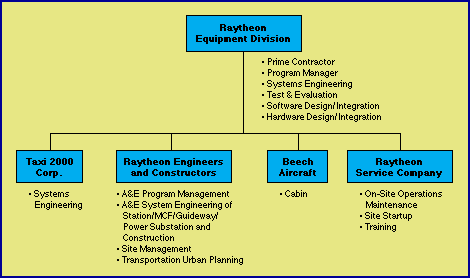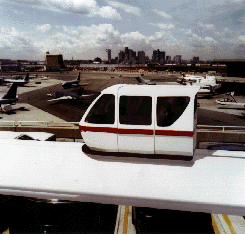
PRT 2000 system development team (Taxi 2000 was no longer involved after 1984).
Development History and Commercialization Plans
After 13 years of PRT study, the design of what became PRT 2000 began in the three
quarters of Senior Mechanical Engineering Design classes during the academic year 1981-82
and continued under a patent-development grant from the University of Minnesota, followed
by private investment funds. With the help of University of Minnesota administrators, a
company, partly owned by the University, was formed in June 1983 to develop the new
system.

PRT 2000 system development team (Taxi 2000 was no longer involved after 1984).
In April, 1984, an agreement was reached with Davy McKee Corporation's Chicago Technical Center, which intensified the development effort by developing bid packages and refining cost estimates on all subsystems. About 150 separate pieces of analysis were completed to quantify the component specifications. Computer simulations were developed to analyze and synthesize the guideway configuration, the vehicle propulsion and control system, station operations and to determine all forces and deflections in passing through the critical branch sections of the guideway under extreme loading conditions.
Required technology within the current art was found for each component of the system, so that it became clear that the construction of a demonstration would be straightforward. Peerless Welders of St. Paul built a 9.14m section of guideway to study manufacturing problems and to permit detailed cost analysis. Unico Inc. of Racine built a 30m test track. The one new factor was the assembly of these components into a new configuration. Suppliers were found ready to proceed with detailed design and construction of a test system.
In 1986, circumstances caused the effort to shift to Boston where, in 1987, executives and engineers at Raytheon and other organizations became interested, assisted with application studies, and caused a thorough review of the design to be undertaken.
The result was that the planned development program, time schedule and cost were corroborated. Credibility of the design, a fundamental element in overcoming the deficiencies of the past, was further increased through a study performed in 1988 by the Advanced Transit Association, and through the efforts of its Chairman, Thomas H. Floyd, Jr.
These efforts combined to make possible a successful bid to perform a one year, $1.5M study of PRT for the Northeastern Illinois Regional Transportation Authority. The study, managed by Stone & Webster Engineering Corporation, was completed in the spring of 1992. It found that development of the system is straightforward, and the costs and schedules produced previously were reasonable. Four Chicago suburbs (Deerfield, Lisle, Rosemont, and Schaumburg) became candidates for the first demonstration and in April 1993 Rosemont was selected. On June 3, 1993, the RTA Board voted to proceed with hardware development under the leadership of Raytheon Company.
The hardware development program will prove the performance of PRT 2000 on an oval track with one off-line station and three prototype vehicles at Raytheon's Equipment Division Headquarters in Marlborough, Massachusetts, USA. The prototype test program is expected to be completed in 1996, following which the Rosemont demonstration is planned. Additional deployments in the United States and abroad are being considered in parallel.

Boston's Logan Airport offers a potential site for implementing a PRT 2000 system.
Return to PRT Home Page